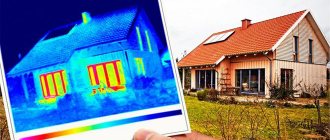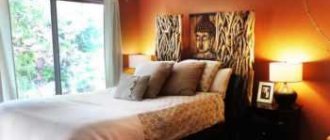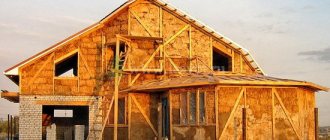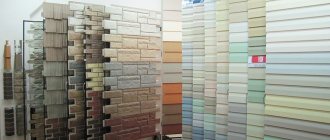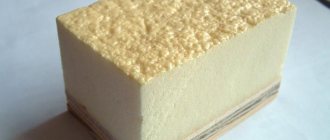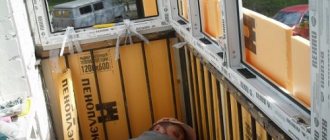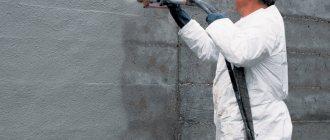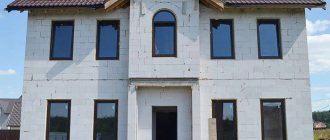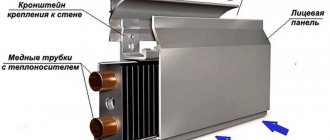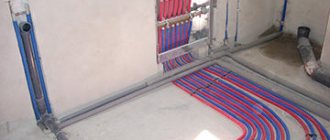Heating a room using a heated floor system has been successfully used for quite a long time. Modern residential building projects involve the use of a combined system - warm water floors and warm water walls.
Often it is used in combination, and sometimes one of them is used separately. It all depends on the wishes and preferences of the owners of residential buildings and premises.
We will try to briefly consider the advantages and disadvantages of each system, and in what cases to give preference to one or another of them. As well as the technology for installing such systems on our own.
Water heated floor: pros and cons of arrangement and operation
Pros:
- Economical – heating living spaces with warm liquid is more profitable and economical than using electric heated floors.
- Safe operation - no potential burns or electric shocks.
- Long service life - more than 25 years without various types of repairs.
- The air in a heated room is not subject to drying out; it has comfortable humidity.
- Does not take up useful space in the room.
- Possibility of combination with other types of heating.
Minuses:
- This type of heating cannot be installed on flights of stairs.
- Difficulties when installing in multi-apartment high-rise buildings - the difficulty of obtaining permission to carry out installation work, as well as water hammer, which can disable the system with subsequent flooding of the neighbors below.
- The installation cost is higher than installing an electric heated floor.
Doctors warn: heated flooring does not need to be installed in all rooms of a house or apartment. Small particles of dust and dirt can rise up with warm air and provoke allergic reactions.
Advantages and disadvantages of warm walls
Before moving on to directly listing the disadvantages of such systems , I immediately want to clarify the situation with their operating principle, which in itself is one big disadvantage. Most people know that heat in a room is distributed by convection or radiation. The essence of convection is that warm air immediately rises, and thermal radiation spreads from the heating device to a maximum of twenty centimeters, and then, again, the principle of air convection is activated.
Now think about what will happen to the heat in the case where the wall is one large heating element - absolutely right, a twenty-centimeter section of space next to the wall , then the heat will go up and will be under the ceiling, warming up the floor of the neighbors. In general, the situation is something like this: it’s cold above the floor, hot under the ceiling, and so-so in the middle. Do you think it would be comfortable to live in such a room?
Naturally, not very much. You will say that there are still batteries? Yes, there is, but then the meaning of heating with a warm wall is lost as such - the only reasonable explanation that can be found for the use of this technology is pampering. You can, of course, use it to dry wet walls, but, again, it will be cheaper and easier to properly seal interpanel or interblock seams.
Now, as for all the other disadvantages that infrared warm walls and all other systems for vertical surfaces in the house . There are many of them, but we will focus exclusively on significant shortcomings.
- along the heated wall . Not only will it reduce the efficiency of heating the room, but also the furniture itself, under the influence of heat, will lose moisture and dry out. In such conditions it will not last long.
- Having installed a heated floor on the wall , you can’t expect to hang anything on it. Paintings, modern TVs, carpets - all this will become inaccessible to you for one simple reason: when installing fasteners, you will probably damage the heating elements. In principle, you can plan in advance what will hang and where, but in most cases our people think about it at the very last moment.
- Large heat losses. I won’t talk for a long time here, because everything is already clear - for the most part, the heating elements will heat the wall, and through it the heat will certainly begin to evaporate outside.
- Moreover, these heat losses lead to another, no less important negative point. Dew point - it moves inside the wall. In winter, moisture will accumulate there, or rather, condensation, which forms on the border between warm and cold. This moment has two unpleasant nuances - where it is warmer, all kinds of mold fungi will develop, and where it is very cold, the wall will freeze in winter. The result of freezing and thawing cycles will certainly be destruction.
In general, if you haven’t yet decided to install warm walls , then at least don’t rush with them - here you need to think carefully and weigh the pros and cons. Consult with specialists, with people who have already managed to try this heating and, if after this you are still confident in the need to heat the walls , then you can act.
Water warm walls
The walls are heated with liquid in the same way as the floor. In other words, a water heated floor is installed in the wall. All the positive qualities inherent in the floor are also characteristic of the walls. But warm water walls also have advantages unique to them.
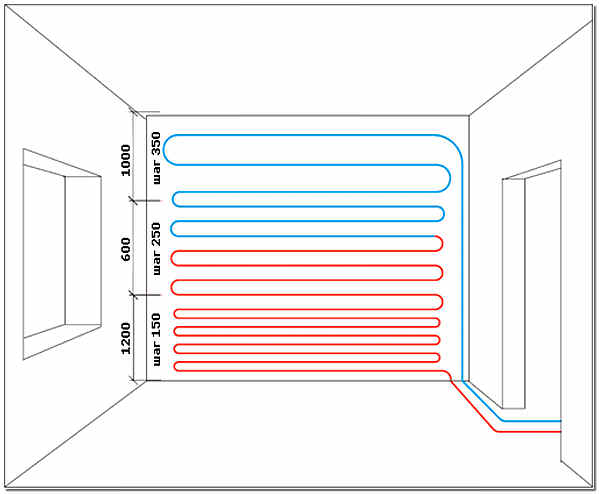
- Walls, unlike floors, which heat the room with a heated concrete screed, heat the space with thermal rays (radiant heating method). With this method of heat exchange, a comfortable temperature is considered to be 18°C – 20°C. With radiator or floor heating – 22°C. Small savings in person.
- The plaster layer on the wall is much thinner than the concrete floor screed, so heat transfer occurs faster and more efficiently.
- The movement of air flows is almost minimal, which does not contribute to excessive movement of dust and protects our health.
- Possibility of using less powerful and therefore cheaper pumps, unlike pumps for water heated floors.
- The pipe can be laid relatively arbitrarily; the laying step does not matter much. Recommended: up to a height of 120 cm - the pipe is laid every 15 cm, from 120 to 180 cm - every 25 cm, if you want to raise it higher - every 35-40 cm.
- Important! Since radiant heat exchange predominates with this heating method, there is no need to place high furniture against these walls .
- If heating is installed in the wall separating two rooms, then both of them will be heated.
- The ability to use not only for heating, but also for cooling, instead of air conditioners constantly blowing into the back of your head.
When pumping cold water into the floor, you can easily catch a cold if you forget to put on your slippers a couple of times.
The disadvantages include, again, the impossibility of installing in high-rise buildings and the relatively high cost, although slightly lower than heated floors.
At first glance, you might think that warm water walls are better than a warm water floor. But it is not so. It is more preferable to have a heated floor in the bathroom. It will dry the air from the very surface.
When arranging a kitchen, you need to make both the floor and the walls waterproof. In summer, air conditioning will not be needed, and in spring and winter, comfort will be created by a warm floor.
What to give preference to in living rooms is up to you. But as advice, we suggest heating them with the walls, and laying carpet on the floor or insulating it in other ways.
Technology for laying heated floors in screeds
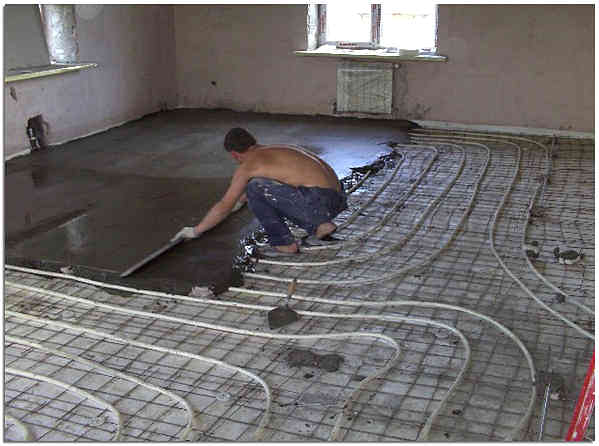
Prepare a flat horizontal concrete base. This can be done in two ways: either using a self-leveling self-leveling floor, or using a cement-sand mortar.- We lay waterproofing and insulation materials on the dried screed. Typically this is expanded polystyrene with a thickness of 5 to 10 cm for the first floor and from 2 to 5 cm for the subsequent ones. Sometimes you can get by with penofol.
- Then we put the reinforcing mesh, and lay the pipes on it according to the instructions. After this, we connect the pipes to the distribution combs and put them under pressure, which should be excessive.
- We finish by pouring the screed over the pipes, with a thickness of 4 to 6 cm.
When pumping cold water into the floor, you can easily catch a cold if you forget to put on your slippers a couple of times.
Wall mounting technology
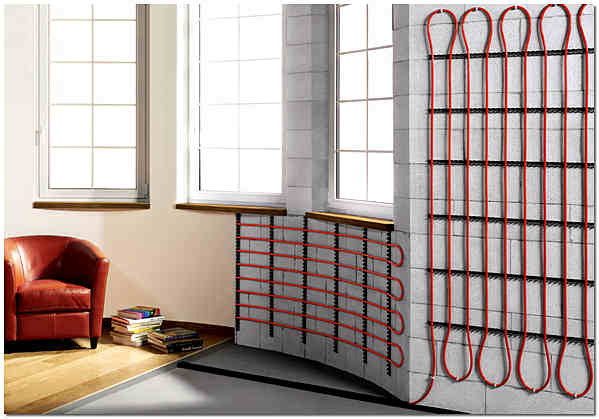
We attach a reinforcing mesh to the wall, and lay pipes on it in a snake (attaching them to the wall).- We fix the pipes with a layer of plaster, filling the space between them.
- Then we attach the second reinforcing mesh and finish it with plaster.
- When building a house, it is necessary to install a reinforcing frame onto which the pipes are attached. After this, you need to make formwork for filling with mortar.
It is better to insulate load-bearing walls from the outside so that the freezing point is established in the insulation.
Please rate the article by selecting a star ( 5 votes, rating: 4.80 out of 5)
Share the news on social networks
- Related Posts
- Leveling walls for wallpaper and painting with putty and plasterboard sheets
- How to make a cement floor screed
- How to choose wallpaper for painting walls in a private house
« Previous entry
Warm walls: what are they made of?
Anyone who is familiar with the principle of making heated floors will quickly understand that the technology for heating walls is completely identical to them - nothing new has been invented here. You could even say that, on the contrary, the warm walls , compared to the floors, have degraded somewhat. In most cases, material such as reflective thermal insulation is removed from the structure - with this formulation of the question, the heating element warms up the wall, and the heat goes outside. At the very least, this is incorrect - a heat insulator can only be installed if the walls are covered with plasterboard, which, as you understand, is not always advisable. Otherwise, this is the same technology for heating surfaces, which can be carried out in three ways, or rather, using three types of heating elements.
- Warm walls
- Warm walls
- Warm walls
- Warm walls
- Warm walls
- Warm walls
- Warm walls
- Warm walls
- Warm walls
- Warm walls
- Warm walls
- Warm walls
House heating
- Water warm walls . The optimal solution if your house or apartment has an individual liquid heating system.
- Electric warm walls are cables or ready-made mats, the energy consumption of which is quite high.
- Film heated floor on the wall - electric or infrared elements, which in this situation with walls can be called the most optimal solution, and then only when they are installed in a circle: on the ceiling, walls and floor.
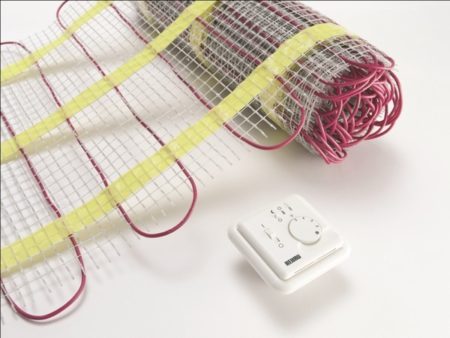
Warm walls
In principle, regarding the question of what warm wall systems , there is nothing more to add, except to mention small materials, without which not a single installation of such systems . These are all kinds of fasteners, if their installation , then insulation and the like.
Do-it-yourself warm walls: installation technology
It doesn’t matter what heating element we are talking about - the essence of warm wall does not change. The only difference between the various heating methods may lie only in the subtleties of mounting the heater - otherwise, this technology has a standard scheme, which can be represented as the following sequence of work.
- Installation and connection of heating elements. Everything is standard here - exactly the same as in underfloor heating . If pipelines act as heating elements, they are attached to the wall using special fastening strips or clips. An indispensable condition for the installation of warm water walls is the laying of pipes in a snake from the bottom up along the coolant flow - a spiral pipe laying pattern is not suitable here, since the coolant must rise up the walls not only through a pump, but also through natural circulation. When it comes to electrical cables, they are also secured mechanically. The mats are glued with a special cement-based glue, and as for all kinds of films, they require a smooth plastered surface - in most cases they are laid behind drywall or panels.
- Wall decoration. This point applies to a greater extent to electric cable heating elements and pipelines. With films everything is much simpler - they are glued to the wall between the fastening of the frame, which is subsequently covered with something. The main condition for such finishing of warm walls is the creation of convection openings above the floor and under the ceiling for the exit of warm air from behind the cladding and the influx of cold air there. Unlike film technologies, electrical cables and pipes can also be plastered on top. Everything is standard here - first the beacons are installed, then rough plaster is applied, and a reinforcing mesh is installed on top of almost fresh material (you can use a non-metal mesh). And then a finishing layer of plaster is made, which is puttied and finished with finishing decorative materials.
As you can see, warm walls are a fairly simple technology, and they are practically no different from floor heating systems. Perhaps it would even have become widespread if it were not for its uselessness - it is rare to find a truly rational use for it.
Request a call
Call around the clock, we work without holidays and weekends.
Our contact page
The emergency service operates around the clock in Moscow and the Moscow region. Departure to the nearest areas is planned according to the schedule.
8 (495) 744 -67 -74
Heating of private houses in detail by cost
- Heating 100 m² Cost of work 49,500 rub.
- Heating 150 m² Cost of work 52,500 rub.
- Heating 200 m² Cost of work 72,500 rub.
- Heating 250 m² Cost of work 87,500 rub.
Heating 100 m²
| Cost of work | from 49,500 rub. |
| Cost of equipment | from 120,000 rub. |
Heating 100 m²
Heating 150 m²
| Cost of work | from 52,500 rub. |
| Cost of equipment | from 200,000 rub. |
Heating 150 m²
Heating 200 m²
| Cost of work | from 72,500 rub. |
| Cost of equipment | from 250,000 rub. |
Heating 200 m²
Heating 250 m²
| Cost of work | from 87,500 rub. |
| Cost of equipment | from 300,000 rub. |
Heating 250 m²
Heating services: Baseboard heating, Water heated floor, Radiator heating, Warm wall
